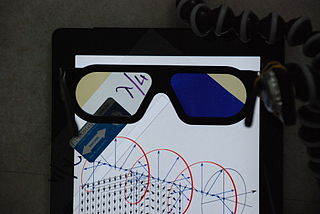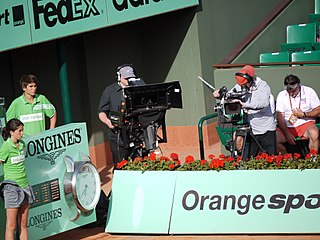
A digital camera is a camera that captures photographs in digital memory. Most cameras produced today are digital, largely replacing those that capture images on photographic film. Digital cameras are now widely incorporated into mobile devices like smartphones with the same or more capabilities and features of dedicated cameras. High-end, high-definition dedicated cameras are still commonly used by professionals and those who desire to take higher-quality photographs.

Stereoscopy is a technique for creating or enhancing the illusion of depth in an image by means of stereopsis for binocular vision. The word stereoscopy derives from Greek στερεός (stereos) 'firm, solid', and σκοπέω (skopeō) 'to look, to see'. Any stereoscopic image is called a stereogram. Originally, stereogram referred to a pair of stereo images which could be viewed using a stereoscope.

A camcorder is a self-contained portable electronic device with video and recording as its primary function. It is typically equipped with an articulating screen mounted on the left side, a belt to facilitate holding on the right side, hot-swappable battery facing towards the user, hot-swappable recording media, and an internally contained quiet optical zoom lens.

A 3D display is a display device capable of conveying depth to the viewer. Many 3D displays are stereoscopic displays, which produce a basic 3D effect by means of stereopsis, but can cause eye strain and visual fatigue. Newer 3D displays such as holographic and light field displays produce a more realistic 3D effect by combining stereopsis and accurate focal length for the displayed content. Newer 3D displays in this manner cause less visual fatigue than classical stereoscopic displays.

A digital single-lens reflex camera is a digital camera that combines the optics and the mechanisms of a single-lens reflex camera with a solid-state image sensor and digitally records the images from the sensor.

A polarized 3D system uses polarization glasses to create the illusion of three-dimensional images by restricting the light that reaches each eye.

Advanced Photo System type-C (APS-C) is an image sensor format approximately equivalent in size to the Advanced Photo System film negative in its C ("Classic") format, of 25.1×16.7 mm, an aspect ratio of 3:2 and Ø 30.15 mm field diameter. It is therefore also equivalent in size to the Super 35 motion picture film format, which has the dimensions of 24.89 mm × 18.66 mm and Ø 31.11 mm field diameter.

The Stereo Realist is a stereo camera that was manufactured by the David White Company from 1947 to 1971. It was the most popular 35 mm stereo camera ever manufactured and started the era of popular stereo photography of the mid 20th century.

In digital photography, the image sensor format is the shape and size of the image sensor.
Digital 3D is a non-specific 3D standard in which films, television shows, and video games are presented and shot in digital 3D technology or later processed in digital post-production to add a 3D effect.

3D television (3DTV) is television that conveys depth perception to the viewer by employing techniques such as stereoscopic display, multi-view display, 2D-plus-depth, or any other form of 3D display. Most modern 3D television sets use an active shutter 3D system or a polarized 3D system, and some are autostereoscopic without the need of glasses. As of 2017, most 3D TV sets and services are no longer available from manufacturers.

The Fujifilm FinePix Real 3D W series is a line of consumer-grade digital cameras designed to capture stereoscopic images that recreate the perception of 3D depth, having both still and video formats while retaining standard 2D still image and video modes. The cameras feature a pair of lenses, and an autostereoscopic display which directs pixels of the two offset images to the user's left and right eyes simultaneously. Methods are included for extending or contracting the stereoscopic baseline, albeit with an asynchronous timer or manually depressing the shutter twice. The dual-lens architecture also enables novel modes such as simultaneous near and far zoom capture of a 2D image. The remainder of the camera is similar to other compact digital cameras.

A mirrorless camera is a camera that does not have a mirror. Though most cameras, including those used in smartphones, lack mirrors, the term mirrorless is primarily used to describe digital interchangeable lens cameras, in order to distinguish them from DSLRs, which have historically dominated interchangeable lens cameras. Lacking a mirror system allows the camera to be smaller, quieter, and lighter.
A 3D camcorder can record 3D video.

Stereo photography techniques are methods to produce stereoscopic images, videos and films. This is done with a variety of equipment including special built stereo cameras, single cameras with or without special attachments, and paired cameras. This involves traditional film cameras as well as, tape and modern digital cameras. A number of specialized techniques are employed to produce different kinds of stereo images.

















